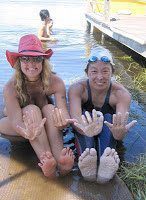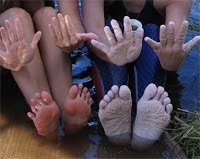 Every open water swimmer knows how their fingertips get wrinkles after being in the water a long time. For some, the wrinkles appear quickly and for others, wrinkly fingers takes a longer time. But the hands and feet generally appear a lighter shade than normal and there always seems to be excess skin on the hands after a swim, especially the longer one is submerged in the water.
Every open water swimmer knows how their fingertips get wrinkles after being in the water a long time. For some, the wrinkles appear quickly and for others, wrinkly fingers takes a longer time. But the hands and feet generally appear a lighter shade than normal and there always seems to be excess skin on the hands after a swim, especially the longer one is submerged in the water.
A study that was published in Biology Letters and reported in ScienceNOW sheds some light on why this normal physiological process occurs and what are the benefits. The early experiments also raise a variety of subsequent questions that open water swimmers can answer for themselves.
 Wrinkled fingertips helps human get a stronger grip on slippery objects, especially those underwater.
Wrinkled fingertips helps human get a stronger grip on slippery objects, especially those underwater.
Better to grab a water bottle at a feeding station or feeding stop, so say open water swimmers. Swimmers know that if they swim long enough, wrinkles are as common as a goggle tan.
ScienceNOW reports that scientists previously believed that wrinkles on the fingers were caused by osmosis—swelling of the outer layer of the skin as water seeped into cells.
But recent experiments suggest that the wrinkles are produced by nerves that automatically trigger constriction of the blood vessels beneath the skin. This causes the underlying tissue to shrink.
Tom Smulders, an evolutionary biologist at Newcastle University in the United Kingdom, tested a theory by Romann Weber of Rensselaer Polytechnic Institute, Mark Changizi of 2AI Labs and a team that the folds of skin help improve grip on wet objects. In a report published in Biology Letters, he described how he had volunteers soak their hands in 40°C water for 30 minutes and then picked up and handled a variety of wet objects and found they completed the experiment 12% faster than when their fingers were unsoaked and wrinkle-free.
Others have observed that your dominant hand tends to wrinkle faster so if you are right-handed, your right hand wrinkles earlier than your left hand. Additionally, it seems that hands wrinkle faster after taking time off from training. That is, if you swim daily for at least an hour, and then take a vacation from training, your fingers tend to wrinkle faster the first few days you resume training.
If there is a group of individuals who these scientists can test, it is open water swimmers who can conduct a variety of tests to determine differences in “wrinkleness” and “wrinkleability”. Do wrinkles occur equally or faster between fingers and toes? Or the same between submersion in chlorinated water, fresh water and salt water? Or the same in warm water versus cold water? Or is the rate of getting wrinkles the same between young and old, male and female, and different ethnicitis?
These are experiments that open water swimmers can conduct for themselves as they train in pools, lakes and oceans as well as when they sit in the tub after a long, cold workout in the ocean.
Photo shows Yuko Matsuzaki after her 83 km solo swim in Lake Cane, Florida where she swam non-stop for 33 hours 24 minutes. “Right after I finished the marathon swim, I walked onshore and my sweet friend gave me some “shiatsu” massage slipper” with many bumps on the slippers. My feet were super wrinkled after the swim. I had weak skin and it was waaaaaaaaaaaay too painful. I threw away the slippers and learned, “After long swim, no shiatsu massage shoes.”
Copyright © 2012 by Open Water Source